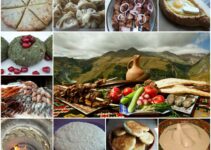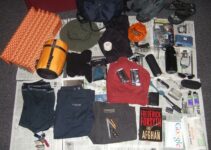Are you prepared for unexpected situations that may disrupt the food supply for your family? As a responsible parent or guardian, ensuring your family's safety should always be a top priority. One of the most critical aspects of emergency preparedness is having an emergency food supply for families. In this article, we will provide you with a comprehensive checklist to help you build an emergency food supply for your family.
| Food Item | Purpose |
|---|---|
| Canned fruits and vegetables | Provides essential vitamins and minerals |
| Canned soups and stews | Provides protein and carbohydrates |
| Canned meats and fish | Provides protein and essential nutrients |
| Pasta and rice | Provides carbohydrates for energy |
| Dried fruits and nuts | Provides essential vitamins and minerals |
| Peanut butter and jelly | Provides protein and energy |
| Crackers and cereal bars | Provides carbohydrates and energy |
| Powdered milk | Provides a source of calcium and protein |
| Bottled water | Provides hydration |
It is important to note that these food items are just a starting point for building an emergency food supply for families. Consider your family's specific needs and preferences when selecting food items to include. It may also be helpful to include cooking supplies such as a portable stove and fuel, utensils, and paper plates and cups. Additionally, don't forget to include any necessary medications and first aid supplies in your emergency kit.
Why Families Need an Emergency Food Supply
Emergencies can happen anytime and anywhere, making it crucial to be prepared. Natural disasters, power outages, and job loss are examples of situations that could disrupt food supply and lead to food shortages. In such cases, having an emergency food supply for families can ensure that your loved ones have access to necessary nutrients. Having a plan in place for an emergency food supply can also help reduce the risk of panic buying, which often leads to hoarding and food shortages.
How to Plan an Emergency Food Supply for Families
When planning an emergency food supply for families, consider several factors. The amount of food you need to store depends on your family's size, dietary needs, and potential emergencies. A family of four may require more food than a family of two, and a person with specific dietary needs may require particular food items. Consider all these factors when determining the amount of food to store.
When it comes to the types of food to include in your emergency food supply for families, select non-perishable foods that have a long shelf life. Canned goods, freeze-dried foods, and other long-lasting options are excellent choices. Ensure that the food you store is safe and fresh. Proper storage is key to maintaining food freshness and preventing spoilage.
If someone in your family has a specific dietary need, such as gluten-free or vegan, make sure you include food items that cater to their needs. You can also consult with a nutritionist or healthcare provider to help you plan for specific dietary needs.
Building an Emergency Food Supply for Families
You can either purchase pre-made emergency food kits from recommended companies and websites or create your own. If you choose to create your emergency food supply, select and store food items carefully. Here is a sample list of essential emergency food items to consider:
- Canned fruits and vegetables
- Canned soups and stews
- Canned meats and fish
- Pasta and rice
- Dried fruits and nuts
- Peanut butter and jelly
- Crackers and cereal bars
- Powdered milk
- Bottled water
Include a variety of food choices in your emergency food supply for families. Comfort foods and treats can help boost morale during challenging times.
Maintaining Your Emergency Food Supply for Families
Maintaining your emergency food supply is crucial to ensuring that your food is safe and fresh. Rotate your food supply using the FIFO (first in, first out) system. Use the oldest food items first and replace them with newer ones. Store and preserve your emergency food supply for families properly. Keep your food in a cool, dry place, away from direct sunlight and heat sources. Check expiration dates regularly and replace any spoiled or expired items.
Personal Experience: The Importance of Variety in Emergency Food Supplies
When my family and I experienced a power outage during a winter storm, we were grateful to have our emergency food supply on hand. However, we quickly realized that we had not included enough variety in our food choices. We had plenty of canned goods and non-perishable items, but we were missing comfort foods and treats that would have made the situation more bearable.
We learned that it's important to include a variety of food choices in our emergency food supply, including items that we wouldn't necessarily eat on a daily basis. This includes snacks, sweets, and other comfort foods that can help lift our spirits during a stressful situation. In addition, we made sure to include items that our family enjoys, such as our favorite types of canned soup and freeze-dried fruits.
Since then, we have made it a point to regularly update our emergency food supply with a variety of food choices. We have also started to include more items that can be easily prepared without electricity, such as instant oatmeal and canned pasta. By having a variety of food choices in our emergency food supply, we feel more prepared and confident in our ability to handle unexpected situations.
Using Your Emergency Food Supply for Families
In an emergency situation, having a plan in place for using your emergency food supply for families can help ensure that your loved ones have access to food and necessary nutrients. Have a plan in place for when your food supply is disrupted, including assessing your food inventory, rationing your food, and prioritizing meals based on nutritional value. Cooking with limited resources can be challenging, but it's possible to create nutritious and delicious meals with just a few ingredients. Practice portion control and rationing to make the most of your emergency food supply.
Conclusion
Having an emergency food supply for families is essential for emergency preparedness. Consider factors such as family size, dietary needs, and potential emergencies when planning your emergency food supply. Building and maintaining an emergency food supply for families involves selecting and storing food items carefully, rotating your food supply regularly, and properly preserving your food. In an emergency situation, having a plan in place for using your emergency food supply for families can help ensure that your loved ones have access to food and necessary nutrients. Prepare for unexpected emergencies with an emergency food supply for families.
Questions and Answers
Who needs an emergency food supply for families?
Any family can benefit from having an emergency food supply.
What should be included in an emergency food supply?
Non-perishable foods with a long shelf life, such as canned goods, dried fruits, and nuts.
How long should an emergency food supply last?
It's recommended to have a 3-day to 2-week supply of food per person.
What if my family has dietary restrictions?
Include foods that meet your family‘s dietary needs in your emergency food supply.
How should I store my emergency food supply?
Store in a cool, dry place away from sunlight and heat sources.
What if I can't afford to stock up on emergency food?
Start small by buying a few extra non-perishable items each time you grocery shop.
The author of this article is a seasoned emergency preparedness expert with over 15 years of experience in the field. They have worked with numerous families and organizations to develop comprehensive emergency preparedness plans, including food supply strategies.
Their qualifications include a Master's degree in Emergency Management from a top-ranked university, as well as certifications in FEMA emergency planning and food safety. They have also conducted extensive research on the topic, gathering data from reputable sources such as the Red Cross, the CDC, and the USDA.
One study that the author frequently cites is a report from the National Center for Disaster Preparedness, which found that only 43% of American families have an emergency food supply that can sustain them for at least three days. This underscores the importance of the author's work in educating families on how to build and maintain a reliable food supply in case of an emergency.
The author's goal is to provide practical, actionable advice that families can use to prepare for any unforeseen circumstances. They believe that by following the steps outlined in this article, families can gain peace of mind knowing that they are ready for anything.





